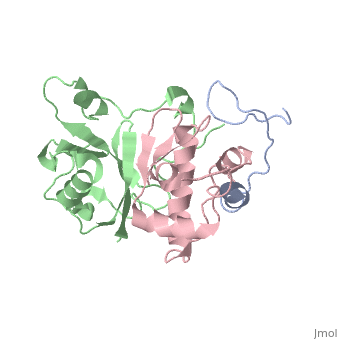2ma9
From Proteopedia
(Difference between revisions)
| Line 1: | Line 1: | ||
==HIV-1 Vif SOCS-box and Elongin BC solution structure== | ==HIV-1 Vif SOCS-box and Elongin BC solution structure== | ||
| - | <StructureSection load='2ma9' size='340' side='right' caption='[[2ma9]], [[NMR_Ensembles_of_Models | 20 NMR models]]' scene=''> | + | <StructureSection load='2ma9' size='340' side='right'caption='[[2ma9]], [[NMR_Ensembles_of_Models | 20 NMR models]]' scene=''> |
== Structural highlights == | == Structural highlights == | ||
| - | <table><tr><td colspan='2'>[[2ma9]] is a 3 chain structure with sequence from [ | + | <table><tr><td colspan='2'>[[2ma9]] is a 3 chain structure with sequence from [https://en.wikipedia.org/wiki/Hiv-1 Hiv-1] and [https://en.wikipedia.org/wiki/Human Human]. Full experimental information is available from [http://oca.weizmann.ac.il/oca-bin/ocashort?id=2MA9 OCA]. For a <b>guided tour on the structure components</b> use [https://proteopedia.org/fgij/fg.htm?mol=2MA9 FirstGlance]. <br> |
| - | </td></tr><tr id='related'><td class="sblockLbl"><b>[[Related_structure|Related:]]</b></td><td class="sblockDat">[[3dcg|3dcg]]</td></tr> | + | </td></tr><tr id='related'><td class="sblockLbl"><b>[[Related_structure|Related:]]</b></td><td class="sblockDat"><div style='overflow: auto; max-height: 3em;'>[[3dcg|3dcg]]</div></td></tr> |
| - | <tr id='gene'><td class="sblockLbl"><b>[[Gene|Gene:]]</b></td><td class="sblockDat">vif ([ | + | <tr id='gene'><td class="sblockLbl"><b>[[Gene|Gene:]]</b></td><td class="sblockDat">vif ([https://www.ncbi.nlm.nih.gov/Taxonomy/Browser/wwwtax.cgi?mode=Info&srchmode=5&id=11698 HIV-1]), TCEB2 ([https://www.ncbi.nlm.nih.gov/Taxonomy/Browser/wwwtax.cgi?mode=Info&srchmode=5&id=9606 HUMAN]), TCEB1 ([https://www.ncbi.nlm.nih.gov/Taxonomy/Browser/wwwtax.cgi?mode=Info&srchmode=5&id=9606 HUMAN])</td></tr> |
| - | <tr id='resources'><td class="sblockLbl"><b>Resources:</b></td><td class="sblockDat"><span class='plainlinks'>[ | + | <tr id='resources'><td class="sblockLbl"><b>Resources:</b></td><td class="sblockDat"><span class='plainlinks'>[https://proteopedia.org/fgij/fg.htm?mol=2ma9 FirstGlance], [http://oca.weizmann.ac.il/oca-bin/ocaids?id=2ma9 OCA], [https://pdbe.org/2ma9 PDBe], [https://www.rcsb.org/pdb/explore.do?structureId=2ma9 RCSB], [https://www.ebi.ac.uk/pdbsum/2ma9 PDBsum], [https://prosat.h-its.org/prosat/prosatexe?pdbcode=2ma9 ProSAT]</span></td></tr> |
</table> | </table> | ||
== Function == | == Function == | ||
| - | [[ | + | [[https://www.uniprot.org/uniprot/VIF_HV1N5 VIF_HV1N5]] Counteracts the innate antiviral activity of human APOBEC3F and APOBEC3G. Forms a complex with host APOBEC3F and APOBEC3G thus preventing the entry of these lethally hypermutating enzymes into progeny virions. Recruits an active E3 ubiquitin ligase complex composed of elongin BC, CUL5, and RBX2 to induce polyubiquitination of APOBEC3G and APOBEC3F. In turn, they are directed to the 26S proteasome for degradation. Vif interaction with APOBEC3G also blocks its cytidine deaminase activity in a proteasome-independent manner, suggesting a dual inhibitory mechanism. May interact directly with APOBEC3G mRNA in order to inhibit its translation. Seems to play a role in viral morphology by affecting the stability of the viral nucleoprotein core. Finally, Vif also contributes to the G2 cell cycle arrest observed in HIV infected cells (By similarity).<ref>PMID:8184544</ref> <ref>PMID:14557625</ref> [[https://www.uniprot.org/uniprot/ELOC_HUMAN ELOC_HUMAN]] SIII, also known as elongin, is a general transcription elongation factor that increases the RNA polymerase II transcription elongation past template-encoded arresting sites. Subunit A is transcriptionally active and its transcription activity is strongly enhanced by binding to the dimeric complex of the SIII regulatory subunits B and C (elongin BC complex).<ref>PMID:15590694</ref> The elongin BC complex seems to be involved as an adapter protein in the proteasomal degradation of target proteins via different E3 ubiquitin ligase complexes, including the von Hippel-Lindau ubiquitination complex CBC(VHL). By binding to BC-box motifs it seems to link target recruitment subunits, like VHL and members of the SOCS box family, to Cullin/RBX1 modules that activate E2 ubiquitination enzymes.<ref>PMID:15590694</ref> [[https://www.uniprot.org/uniprot/ELOB_HUMAN ELOB_HUMAN]] SIII, also known as elongin, is a general transcription elongation factor that increases the RNA polymerase II transcription elongation past template-encoded arresting sites. Subunit A is transcriptionally active and its transcription activity is strongly enhanced by binding to the dimeric complex of the SIII regulatory subunits B and C (elongin BC complex).<ref>PMID:7638163</ref> <ref>PMID:15590694</ref> The elongin BC complex seems to be involved as an adapter protein in the proteasomal degradation of target proteins via different E3 ubiquitin ligase complexes, including the von Hippel-Lindau ubiquitination complex CBC(VHL). By binding to BC-box motifs it seems to link target recruitment subunits, like VHL and members of the SOCS box family, to Cullin/RBX1 modules that activate E2 ubiquitination enzymes.<ref>PMID:7638163</ref> <ref>PMID:15590694</ref> |
<div style="background-color:#fffaf0;"> | <div style="background-color:#fffaf0;"> | ||
== Publication Abstract from PubMed == | == Publication Abstract from PubMed == | ||
| Line 21: | Line 21: | ||
==See Also== | ==See Also== | ||
| - | *[[HIV and accessory proteins|HIV and accessory proteins]] | ||
| - | *[[Transcription factor SIII|Transcription factor SIII]] | ||
*[[Virion infectivity factor|Virion infectivity factor]] | *[[Virion infectivity factor|Virion infectivity factor]] | ||
== References == | == References == | ||
| Line 30: | Line 28: | ||
[[Category: Hiv-1]] | [[Category: Hiv-1]] | ||
[[Category: Human]] | [[Category: Human]] | ||
| + | [[Category: Large Structures]] | ||
[[Category: Atkinson, R A]] | [[Category: Atkinson, R A]] | ||
[[Category: Bergeron, J R]] | [[Category: Bergeron, J R]] | ||
Revision as of 10:06, 26 May 2021
HIV-1 Vif SOCS-box and Elongin BC solution structure
| |||||||||||

